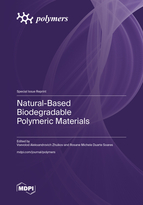Natural-Based Biodegradable Polymeric Materials
A special issue of Polymers (ISSN 2073-4360). This special issue belongs to the section "Biomacromolecules, Biobased and Biodegradable Polymers".
Deadline for manuscript submissions: closed (25 May 2023) | Viewed by 39380
Special Issue Editors
Interests: polyhydroxyalkanoates; atomic force microscopy; biomechanics; nanostructure; poly-3-hydroxybutyrate; biodegradation; biosynthesis; polymers; structural and dynamic; crystallinity; kinetics; alginates; antibacterial drugs; scaffolds; bioengineering; microbiota
Special Issues, Collections and Topics in MDPI journals
Interests: biomaterials; polymeric biomaterials; biomaterial science; biodegradable polymers; 3D printing
Special Issues, Collections and Topics in MDPI journals
Special Issue Information
Dear Colleagues,
One of the fundamental tasks of materials science is the creation of biodegradable composite materials with a controlled destruction time. To solve this problem, researchers have proposed using polymeric materials. Biodegradable polymers are polymeric materials that self-destruct as a result of natural microbiological and chemical processes. Such materials can find actual applications in various areas of human activity.
First of all, the use of biodegradable materials is justified in the field of biomedicine, including for the controlled delivery of drugs and the creation of implants for tissue engineering. The range of scaffolds used for tissue engineering in situ includes hydrogels, aerogels, films, nanoparticles, monolithic, fibrous, microporous, and 3D-printed scaffolds. Biodegradable materials may be functional at the time of implantation or have the ability to perform the intended function and integrate into the host after implantation.
Other applications, such as environmental protection (packaging materials with controlled degradation rates) and agriculture, are also relevant. Edible and/or biodegradable packages formed from multiple compounds (composite materials) are being developed to exploit the functional properties of constituent materials and overcome their respective disadvantages.
We invite you to submit articles and reviews of the latest research in the fields of research on multifunctional biodegradable polymers and the development of new materials based on them.
Dr. Vsevolod Aleksandrovich Zhuikov
Dr. Rosane Michele Duarte Soares
Guest Editors
Manuscript Submission Information
Manuscripts should be submitted online at www.mdpi.com by registering and logging in to this website. Once you are registered, click here to go to the submission form. Manuscripts can be submitted until the deadline. All submissions that pass pre-check are peer-reviewed. Accepted papers will be published continuously in the journal (as soon as accepted) and will be listed together on the special issue website. Research articles, review articles as well as short communications are invited. For planned papers, a title and short abstract (about 100 words) can be sent to the Editorial Office for announcement on this website.
Submitted manuscripts should not have been published previously, nor be under consideration for publication elsewhere (except conference proceedings papers). All manuscripts are thoroughly refereed through a single-blind peer-review process. A guide for authors and other relevant information for submission of manuscripts is available on the Instructions for Authors page. Polymers is an international peer-reviewed open access semimonthly journal published by MDPI.
Please visit the Instructions for Authors page before submitting a manuscript. The Article Processing Charge (APC) for publication in this open access journal is 2700 CHF (Swiss Francs). Submitted papers should be well formatted and use good English. Authors may use MDPI's English editing service prior to publication or during author revisions.
Keywords
- biopolymers
- biodegradation
- tissue engineering
- agriculture
- biomedicine
- scaffolds
- films
- microcarriers
- composites
- packaging
- antimicrobial and fungicidal activity
- coatings
- polysaccharides
- nanoparticles







